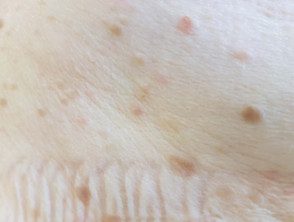What is a bird Pinch?
Bird Mites they are tiny<1 mm de largo), forma ovalada arachnids with eight legs There are several species of mites. The most common species affecting humans in Australia are house mites, Ornithonyssus bursa, of the family Macronyssidae, and the red mite Dermanyssus gallinae, of the family Dermanyssidae [1].
Mite infestation

Stings

Dermanyssus gallinae
Where are mites found?
Bird mites are found naturally where birds, such as poultry, sparrows, starlings, or pigeons, and their nests are found. Mites prefer warm and damp living conditions and are most active during spring and early summer.
What is the mite? infestation?
Mites normally feed on the blood of birds. After the young birds leave their nests, the mites may encounter humans while searching for a new bird. host. Mites can bite anywhere on the human body, but are most often experienced in exposed skin.
Although they can feed on human blood, mites cannot complete their life cycle in humans and cannot burrow under the skin [2–4].
Who gets the mite infestation?
People who are at high risk for mite infestations include poultry farmers, people who live near bird nests, people who raise birds as a hobby (for example, pigeon racers, breeders, pet caregivers, etc.); veterinarians and zoo workers. Exposure to mites can also occur from using second-hand furniture, or from working / living in buildings that have been infested by mites.
What are the clinical features of mite infestation?
A mite infestation presents as itchy bites.
- The bitten areas are intensely itchy, especially at night or early in the morning.
- Symptoms are sometimes described as a "crawling" sensation caused by mites that inject saliva when they feed.
- There may be numerous small reds papules and vesicles (Bite reactions).
What are the complications of mite infestation?
Complications of mite infestation can include:
-
Secondary bacterial infection due to scratching
- Sleep disturbances due to severe itching.
-
Depression or anxiety
How is mite infestation diagnosed?
Suspicion of bird mite infestation should arise when the patient exhibits the symptoms and clinical features of scabies, but does not respond to apparently appropriate treatment. A detailed history should be taken, including the season and time of day the patient's symptoms occur, occupation, hobbies, and living conditions.
The mites are too small to be seen without magnification. They can be collected with clear tape and examined under a microscope. Identifying the species may require consultation with a specialist entomologist (a scientist who studies insects and arachnids).
Which is the differential diagnosis for mite infestation?
Mite infestation can be clinically difficult to distinguish from other mite and insect infestations, such as scabies, fleas, lice, mosquitoes, sand flies, flies, spiders, centipedes, bed bugs, ticks, mosquitoes, and harvest mites. [3.5]. Unlike scabies mites, mites do not make burrows in the skin.
What is the treatment for mite infestation?
Treatment consists of identifying and eradicating the mites. The skin must be cleaned to remove the mites.
- A loofah pad can be used to scrub the skin in the shower.
- Emollients can be added to the bathtub or shower to reduce itching.
-
Coal tar products can be used as a shampoo and body wash once or twice a day.
-
Diluted bleach solution can be used in the shower or bath to reduce infection (bleach is also used to clean the bathroom).
Prescribed treatments
- Current steroids are applied to the bites to decrease inflammation.
- Oral antihistamines can reduce inflammation and itching.
-
Antibiotics are indicated if there is a secondary bacterial infection.
How can mite infestation be prevented?
Mite infestation can be prevented by removing bird nests located near living and work areas.
- Wear fully protective clothing during the process to prevent the transfer of mites to humans.
- If there is a mite infestation in a building, it may be necessary to consult with a qualified pest.control operator.
- To eradicate the mites, treat the area with an approved insecticide surface. spray or insecticide dust [6].
- Heavily infested furniture may need to be destroyed and replaced.
- Carpets require a daily vacuum or, in case of heavy infestation, possibly will require replacement.
- Bedding or clothing should be changed and washed in hot water frequently.
What is the result of the mite infestation?
The bites should disappear after the mites have been successfully eradicated.

